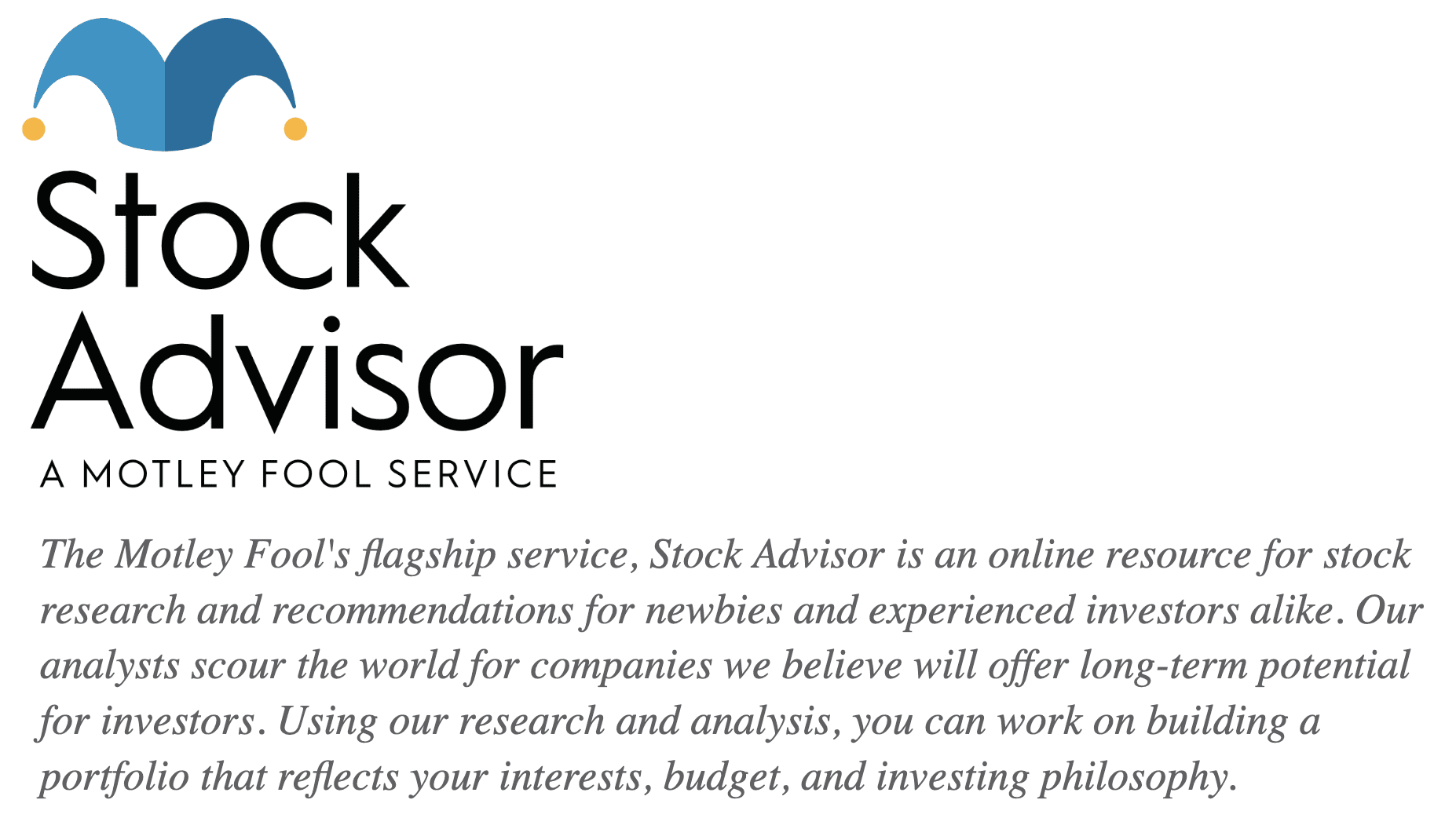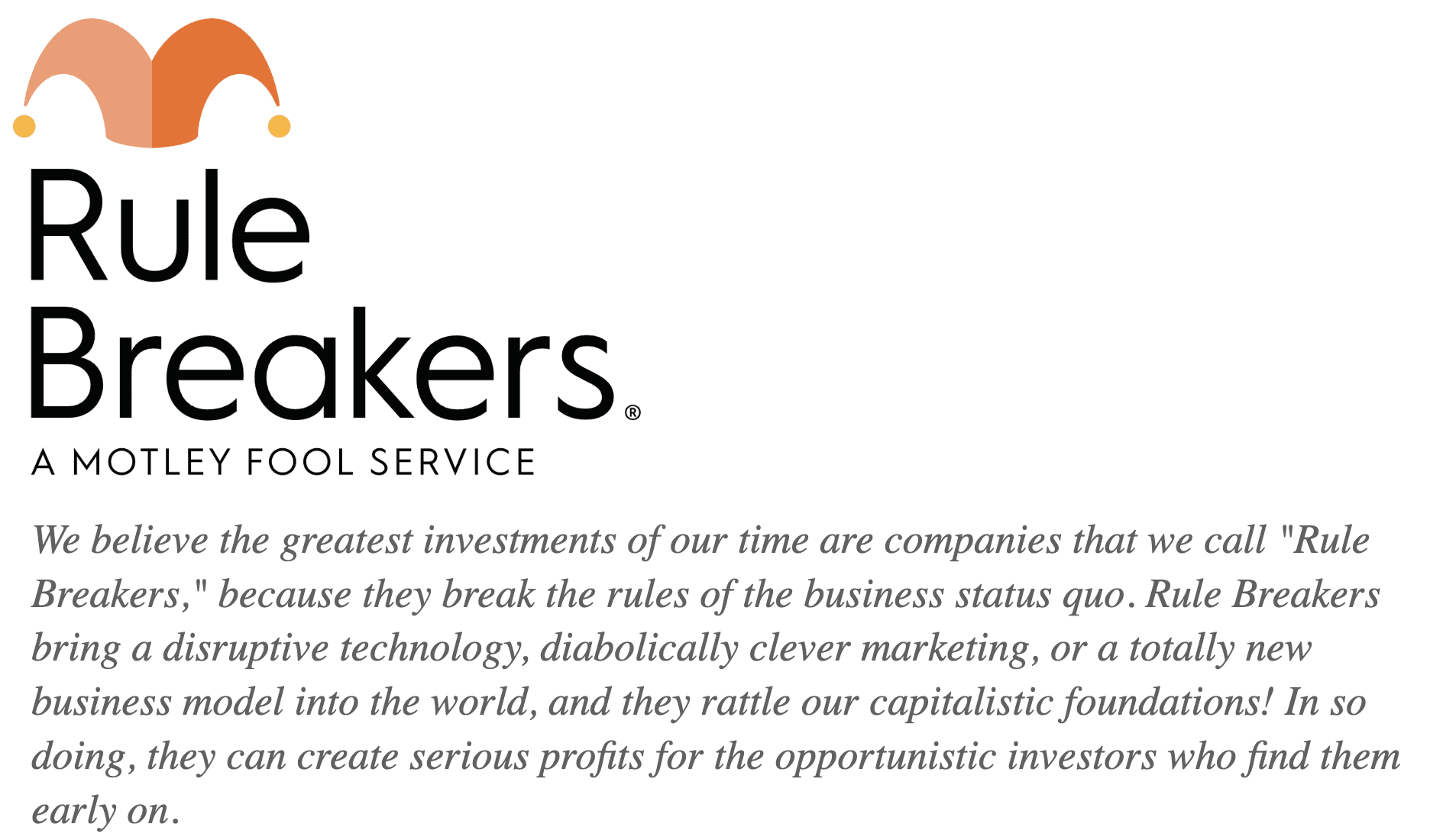The Motley Fool newsletters have been around for almost 20 years, helping investors create a viable portfolio. Now they have two options – the Stock Advisor and Rule Breakers, but which one is best for you?
Let’s figure it out in our comparison of Motley Fool Stock Advisor vs Rule Breakers.
Overview of Motley Stock Advisor
The Motley Stock Advisor is the ‘safer’ of the two Motley Fool newsletters. By safer, I mean they focus on established companies that conservative investors might consider.
Stock Advisor is a paid subscription and was the original paid subscription Motley Fool offered back in 2002. The stocks recommended in the newsletter are typically popular stocks with a stable history. The stocks provided are expected to be held for at least five years. They are also typically predicted to meet or beat the market.
To make the Stock Advisor list, companies must meet the following:
- Have a history of beating the market over consecutive years,
- Be led by their founders
- Have little debt
- Be an industry leader in customer service and corporate culture
The Motley Stock Advisor recommends having at least 25 stocks in your portfolio, but they do all the work, aka research. All you have to do is choose among the stocks they suggest.
The subscription also includes a ‘starter portfolio’ that they feel every investor should have as their foundation.

Performance
Typically, the stocks in the Stock Advisor newsletter have a strong history based on their chosen stocks over the last 20 years. So far, they’ve recommended almost 170 stocks with at least a 100% return.
If you were to calculate the average returns from all stocks in the Stock Advisor, Motley Fool has seen a 326% return, which is pretty impressive if you ask me. To put it into perspective, the S&P 500 has had a 102% return during the same 20 years.
Top Stock Picks
As I said, you can expect popular company names in the Stock Advisor. Here are the top names that most people will recognize.
- Netflix: Netflix took off when it went public in 2002 but has had its peaks and valleys since then. Since the pandemic, though, Netflix stock has seen incredible gains, and since Stock Advisor recommended adding it to investors’ portfolios, it has increased by 10,000%.
- Disney: Even if you aren’t a passionate Disney lover, you likely love them for their stock prices. The theme park and movie conglomerate’s stock has been public since 1940, and since becoming a Stock Advisor pick, it has seen a 6,000% return.
- Amazon: If you’re anything like me, you wish you had Stock Advisor a long time ago and jumped on the Amazon bandwagon. David Gardner, the founder of the Motley Fool, bought Amazon stock in 1997, and his returns skyrocketed. Amazon has returns of 15,000%+ since Motley Fool originally named it as one of the foundational stocks investors should have in their portfolio, and it continues to perform well today.
What To Expect
As a Stock Advisor subscriber, here’s what you can expect:
- A list of starter stocks that every investor should have in their portfolio
- A list of two new stock picks each month to consider adding to your portfolio
- A list of 10 ‘best stocks to buy now’
- Educational resources to help you understand the stock picks
- A like-minded community with the same interests in outperforming the standard market returns
Overview of Motley Fool Rule Breakers
As the name suggests, the Motley Fool Rule Breakers sets out to get even greater returns than Stock Advisor picks. The stocks in this subscription are predicted to have immense growth. As a result, you won’t find typical big-name stocks in this subscription. Instead, it’s for those stocks that are up-and-coming and expected to explode.
Most of the stocks come from emerging markets. For example, eCommerce, cryptocurrency, and artificial intelligence are just a couple of markets the stock picks from the Rule Breaker originate. There are no rules about what industries they’ll come from, just emerging markets that experts predict have incredible returns.
Unlike Stock Advisor, Rule Breaker companies must meet the following:
- Companies brave enough to reach the top of an emerging market
- Have a history of incredible growth
- Strong brand awareness
- Companies that stand out from the competition
- The media caused an overvaluation of the stock

Performance
Rule Breakers originated two years later than Stock Advisor, starting in 2004. Since then, their stock picks have more than doubled the returns of the S&P 500 Index.
Top Stock Picks
Like Stock Advisors, there have been some top stock picks in Rule Breakers, including:
- Shopify: Rule Breakers invests a lot in eCommerce as it was an emerging industry and continues to be an explosive market. For example, Shopify has seen an incredible increase since the first time Rule Breakers recommended it, with almost a 1,200% return.
- MercadoLibre: MercadoLibre is also in the eCommerce industry, so you know full well Rule Breakers is invested in the eCommerce market. As a result, MercadoLibre has seen returns of over 5,700%.
- Tesla: Tesla is one of those stocks that has its ups and downs, but it’s been a tried-and-true stock pick in Rule Breakers for many years. Tesla is a prime example of what Rule Breakers is all about, as they look for companies making a name for themselves and breaking all the rules.
What To Expect
Like Stock Advisor, Rule Breakers have specific factors you can expect, including:
- A list of stocks all Rule Breakers should have in their portfolio to start
- Two new stocks each month everyone should add to their portfolio
- At least five new stock picks each month that is best bought now
The newsletter includes helpful insights and analyses about each stock pick, why they picked them, and reasons to include them in your portfolio.
Motley Fool Stock Advisor vs Rule Breakers: Comparison
Now that I’ve shown you the basics of Stock Advisors vs. Rule Breakers, let’s look at the differences head-on:
Difference in Age
The age difference isn’t too notable. Stock Advisor was Motley Fool’s initial offering in 2002, but Rule Breakers came about soon after in 2004, so they both have a solid history of just about 20 years.
Standard and Poor’s (S&P) 500 vs. Return
The returns of Stock Advisor vs. Rule Breakers are impressive too. Both have beat the market by more than 100% consistently.
Stock Advisor has a higher return average of 374% over the S&P 500 returns, and Rule Breakers has an average of 202% return.
Both lists have beaten the stock market, but Stock Advisors had greater returns. The average stock pick had a 356% return.
Difference in Stock Picks
Stock picks are the main difference when comparing Stock Advisors vs. Rule Breakers. But, again, it comes down to what you’re comfortable choosing.
Do you want to invest in established companies with a proven history or companies that break the rules and are part of an emerging market?
Stock Advisor picks are stable, well-known companies, like I showed above, whereas Rule Breakers are more volatile but tend to have higher returns (and larger losses).
Total Stocks Coverage
When looking at the difference in stock picks, it’s important to note that Stock Advisors usually have over 300 stocks to choose from, whereas Rule Breakers have 200. It’s not a huge difference, but it’s worth noting as you decide which is right for you.
Pros of Motley Fool Stock Advisor
As you’re choosing between Motley Stock Advisor and Rule Breakers, there are some benefits of Stock Advisor over Rule Breakers. Most notably, Stock Advisor focuses on investors with a conservative to moderate risk tolerance and bases the picks on fundamental analysis versus looking for standout stocks that could be volatile.
Cost
Stock Advisor costs $199 a year, and Rule Breakers costs $299 a year. It’s not a huge difference, but that $100 could be money you invest rather than spend on a newsletter. Both subscriptions, however, offer a 30-day money-back guarantee if you aren’t happy with it. Also, you may get a discounted rate for your first year on either subscription.
Real Money Portfolio
The Stock Advisor newsletter will likely have more real money portfolio picks. Motley Fool team members invest their money in real money portfolio stocks. This doesn’t mean they don’t invest in Rule Breaker stocks, because they do, but you’ll find more in the Stock Advisor’s letter.
Pros of Motley Fool Rule Breakers
That being said, Motley Rule Breaker vs. Motley Stock Advisor has some benefits. Most importantly, if you have a high-risk tolerance and want to invest in emerging markets, you’ll be better off with Rule Breakers.
Risk Tolerance
If you’re an experienced investor ready to make the next move away from a conservative portfolio, Rule Breakers can guide you there. You’ll be exposed to more growth-oriented stocks and rely on a stock’s momentum versus a stable, slow-growth stock.
Cost
Rule Breakers costs more, but you must pay for success, right? Because you’re getting access to higher-level information, the cost is higher.
Motley Fool Stock Advisor vs Rule Breakers: How to Choose
I know it’s hard to choose between Stock Advisor and Rule Breakers, especially if you’re already an experienced investor, but here are some factors to consider.
How Are They The Same?
Both services offer a solid number of stock picks each month. They both also offer a foundational portfolio each investor should have before adding the monthly picks. Finally, both services are a guide – you aren’t required to buy the stocks they recommend, but based on their research and analysis, it usually works to your benefit.
How Are They Different?
The largest difference is the type of investor they target. Stock Advisors is for investors with a moderate risk tolerance who want steady stocks. On the other hand, you prefer big-name companies with a proven history.
Rule Breakers is for the riskier investor or the investor willing to take a chance on emerging markets and stand-out companies. It’s best for the experienced investor who already has a baseline conservative portfolio and is ready to take the next step.
Why Not Both?
It’s a myth that you can not subscribe to Stock Advisors and Rule Breakers simultaneously because you can.
Motley Fool has what they call a Market Pass. This premium service offers access to both subscriptions along with small-cap and value investing tips.
Other Advisory Investment Services
Motley Fool may have been one of the first stock advising newsletters, but today there are alternatives. Here’s how they stack up.
About Motley Fool Everlasting
Motley Fool Everlasting is yet another Motley Fool newsletter. This one focus on stocks you can keep long-term, aka forever. This newsletter comes out quarterly with stock picks you can add to your portfolio and forget about.
You can immediately add the stock to your portfolio or add it to your watch list and buy it later. This service is an overall portfolio service, and many members use it as a foundation and then add Stock Advisors or Rule Breakers.
However, if you’re a set-it-and-forget-it investor who doesn’t want to stalk the stock market, Everlasting can be a great way to invest and forget it.
The cost starts at $39 a month, but if you subscribe for a year, it’s only $99 for the first year and then $299 for subsequent years.
About Seeking Alpha
Seeking Alpha is a crowdsourced investing newsletter. Instead of getting picks from the founders, you have access to thousands of investors’ opinions about the stock market. The subscription includes access to articles written by other members, analyses by stock experts, and plenty of advanced charting.
You can look at only current information or go back for decades, looking at stocks’ performances, financial statements, and predictions. You can line up six stocks side-by-side for comparison for faster decisions, or take your time perusing all the information for a deep dive into the stocks you add to your portfolio.
The costs vary by subscription:
- Basic (Free): Real-time stock updates, stock analysis emails, access to charts and analyses, access to some content
- Premium ($189/year + 7 day free trial): Access to all premium content plus stock quant ratings, dividend grades, and author ratings
- Pro ($2,400/year): All premium services plus more ideas, exclusive newsletters, and screen filters
About Zacks Premium
Zacks Premium has been around since 1978 and provides stock picks from various angles. In addition, they offer a variety of lists that vary based on holding time and investment goals.
Zacks Premium Service includes lists like:
- Zacks #1 Rank List: These stocks typically double the S&P 500 return and have the highest potential.
- Style Scores: These stocks are listed based on investing styles, such as value, growth, or momentum.
- Focus List: This list includes 50 top long-term stocks and the reason you should include them in your portfolio.
- Industry Rank: This list of stocks ranks them in order of their capability of beating the market.
- Zacks Earnings ESP Filter: The Earnings Expected Surprise Filter includes a list of stocks predicted to have ‘surprise earnings’ soon.
Zacks Premium costs $249 per year.
About (IBS) Investor’s Business Daily
Investor’s Business Daily is a monthly newsletter that provides insights on stocks and the industry. You can learn about trends and read different company analyses to help you make investing decisions.
The cost is $20 monthly for the first two months and then increases to $34.95 monthly.
Frequently Asked Questions
Motley Fool provides many ways for investors to create customized portfolios. Still, have more questions? Here are some of the most frequently asked questions I get.
What is the purpose of the Motley Fool Newsletter?
The Motley Fool newsletter is meant to help investors create a portfolio to help them reach their financial goals. The newsletter does the research and analysis for you, so you all have to choose the stocks you want and invest in them.
What is Motley Fool Rule Breakers ideal for?
Rule Breakers is for the experienced investor looking to take that next step. You must be risk tolerant and willing to invest in emerging markets and volatile stocks. In addition, you’ll invest in riskier industries and companies that you might not consider on your own.
What is Motley Fool Stock Advisor ideal for?
Stock Advisor is best for the beginner or conservative investor. If you aren’t interested in volatile stocks or want something more conservative, Stock Advisor is the better place to start.
How much should I invest in my chosen stock?
How much you should invest in each stock depends on how much capital you have and how diversified your portfolio is. So don’t put all your money into one stock. Instead, use the advisor’s foundational picks to ensure you have a diversified portfolio before adding to it.
What are other investment advisory services?
If the Motley Fool newsletters don’t appeal to you, there are other investment advisory services, including The Street, Morningstar, Benzinga, and Sector Focus.
What is the best stock advice website out there?
I highly recommend the Motley Fool Stock Advisors (it tops our list of best stock advisor websites). Though the best one for you is the one that caters to your investing style and offers the analysis and information you can use for your investment decisions.
Which stock advisor between Fool and Ruler Breakers has the most alert features?
Rule Breakers has more alert features, mostly because they tell you when to sell because they suggest such volatile stocks. This doesn’t mean you must sell the stock when receiving the alert, but you might consider it.
Motley Fool Stock Advisor vs Rule Breakers: Which Is Best for You?
The top pick between Motley Fool Stock Advisor vs Rule Breakers depends on your goals. If you’re just starting, I highly recommend Stock Advisor. You’ll create a foundational portfolio and gradually add to it.
If you’re an experienced investor looking for a little more excitement and risk, Rule Breakers is worth a shot to see how you like investing in emerging markets and volatile stocks.





No comments yet. Add your own